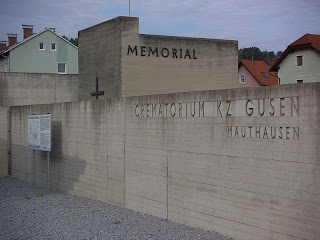The camps of Mauthausen and Gusen belonged to a network of
concentration camps expanded throughout Austria and southern Germany. It is believed that the number of victims of these camps could reach 300,000. The camp work was based on a granite quarry where prisoners came to die working. Besides the camp had numerous methods of extermination, as gas chambers or cold showers.
The camp network that belonged to Mauthausen .
Mauthausen is known as the Spanish camp due to the large number of Republican exiles who were deported there. They came mostly from Vichy France and many of them were captured when they joined the French Resistance. Franco's government disowned them as Spanish and they were transferred to Mauthausen wearing the blue triangle of stateless people.
The Mauthausen and Gusen camps are son close so you can visit both of them in the same day.
Liberation of the camp in 1945.
The Mauthausen and Gusen camps are son close so you can visit both of them in the same day.
VISIT MAUTHAUSEN
Location: here.
Official Website: http://www.mauthausen-memorial.at
Hours: 9:00 to 17:30 (last admission 16:45)
Closed 24 to 26 December, 31 December, 1 January
Normal ticket: € 2
Audioguides German / English: 40 euro deposit
Tours German / English: Saturdays, Sundays and holidays at 14:00 (1 euro / person)
Getting to Mauthausen?
- The field is located in Austria, between Vienna and Salzburg and it's 20 km away from Linz. If we go by car from Vienna or Salzburg we will have to take the A1 and exit at Enns. Always follow the signs for KZ-Gedenkstätte .
- To arrive by public transport is not very well connected. You have to take a train to the town of Mauthausen. Once at the station Mauthasen can either take a taxi to the field (4 km separate it from the station) or take the bus 360 (departs from the station every hour) stop at Linzer Straße / Wasserwerk and then walk 2 km to the entrance. You can click here to see what the whole journey on foot from the station to the field.
Consult bus timetables: www.ooevv.at/index.php?id=1377
Entrance ( photo: Lucignolobrescia )
Because of its structure, the field has remained quite well since its release in 1945. It has been changed due to its conversion into a memorial. In the 60's a cemetery was buit inside where the remains of the victims were buried. The visit provides access to all its facilities, including the old quarry, the gas chambers and crematoria. The website offers a small virtual tour explaining every point in the plane.
From March 12 to May 5, 2013 both the gas chambers and the crematoria will be closed due to reforms. On May 6, 2013 they will open two new historical exhibits and a new memorial, " The Hall of Names ".
Gas chamber ( photo: Lucignolobrescia )
Crematorium.
The stairs of death at Mauthausen. Prisioners had to go up this staircase of 186 more than ten times a day loaded with stone blocks. Many died exhausted.
right photo: Lucignolobrescia
VISITING GUSEN
Location: here.
Official website: http://www.gusen-memorial.at/
Opening hours:
From 1 April to 30 September: Tuesday to Friday from 9:00 to 17:30, Saturday and Sunday from 9: 30 to 17:30
From 1 October to 31 March: Saturdays, Sundays and holidays from 9:30 to 17:30
Closed: December 24 and January 6.
From 1 April to 30 September: Tuesday to Friday from 9:00 to 17:30, Saturday and Sunday from 9: 30 to 17:30
From 1 October to 31 March: Saturdays, Sundays and holidays from 9:30 to 17:30
Closed: December 24 and January 6.
Free admission .
How to get Gusen? Indications are the same as those listed for Mauthausen but when yo take the bus 360 from the train station you will have to get off at b.Mauthausen Bachstraße Gusen stop, three stops more that the other one.
Photo: Rudolf A. Haunschmied
This camp is much less traveled by tourists than Mauthausen. In 2004 they opened an exhibition about the life in the camp, from 1939 to 1945.
In the map you can see the structure of the camp. The official website shows in detail what is in each point.

















